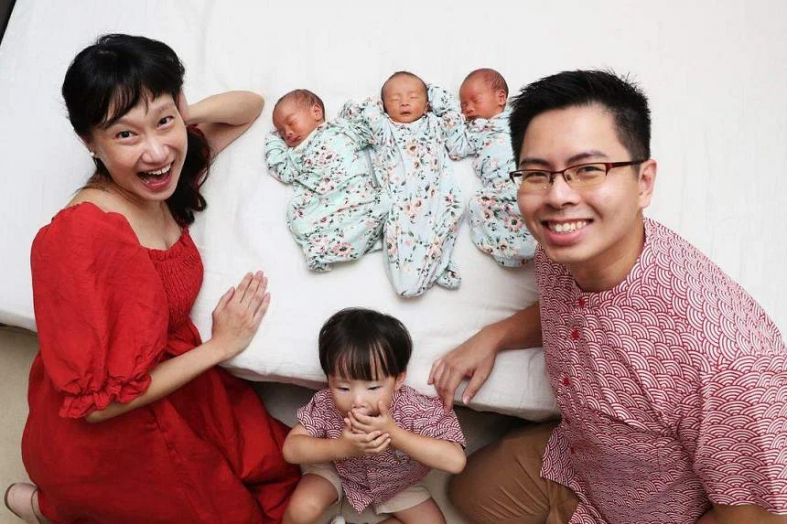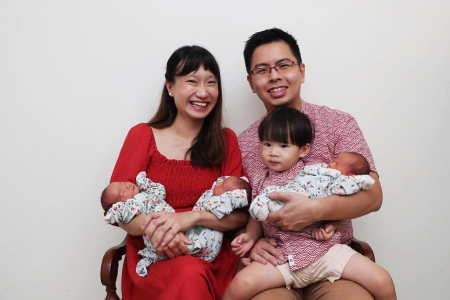From twins to triplets, celebrating CNY with their bundles of joy
A Singaporean couple are celebrating Chinese New Year with a miracle of life they did not anticipate when they embarked on assisted reproduction in 2019 – triplets born from one frozen embryo, giving them the big family they had dreamt of having.
Mr Edwin Chua, 35, and his wife, Dr Claire Low, 33, welcomed Gareth, Kenneth and Seth on Jan 3. They also have a two-year-old son, Keith.
The triplets were born one minute apart at 34 weeks through caesarean delivery at KK Women’s and Children’s Hospital (KKH), weighing between 2.1kg and 2.3kg.
Dr Low, a physiotherapist, told The Straits Times: “We have always wanted a big family and we are very glad the triplets are here with us safely.”
While triplets are already very rare, what is more astonishing is that only one embryo had been implanted in Dr Low’s womb through in-vitro fertilisation (IVF).
The chances of an embryo splitting into triplets are “extremely rare”, said her doctor, Dr Sim Wen Shan, a consultant at KKH’s Department of Maternal Fetal Medicine. A landmark Japanese study found that only 0.04 per cent of pregnancies from a single embryo transfer produced triplets.
Dr Sim said that in IVF procedures, implanting one embryo is now recommended to reduce the chances of having twins or triplets, which can increase the risks in pregnancy.
Mr Chua, an officer in the Singapore Armed Forces, recalled that when they were told they were expecting triplets, “it was a big shock for the both of us”.
The couple, who married in 2014, began to try various fertility procedures, such as intrauterine insemination and IVF, after a few years of marriage failed to produce a child.
Then they conceived Keith naturally. In May 2022, they decided to use one of their frozen embryos to try for a second child.
In her sixth week of pregnancy, Dr Low learnt she was carrying twins.
Dr Low, who is 168cm tall and weighs 52kg, said: “I was really very scared as I am small-sized. I was not sure if I could carry twins.”
But Mr Chua was over the moon, as he had always wanted a big family.

At a follow-up scan two weeks later, their doctor at the time, who practises at another hospital, went silent in the middle of it.
The couple looked at his serious expression and feared the worst – that Dr Low had suffered a miscarriage.
Dr Low said: “My doctor turned the monitor to Edwin and asked him: ‘You can count, right?’”
The couple saw three beating hearts.
“I asked: ‘Is it triplets?’ The doctor said yes,” Mr Chua said. “With triplets, it is a whole magnitude of difference in terms of challenges.”
Dr Low said her doctor could not explain how the twins were now triplets, but he said his only other patient with triplets had had three embryos implanted.
Dr Low added: “I asked my doctor that if I go back the next week, there wouldn’t be four babies, right? He said, ‘Claire, don’t worry. You are not an amoeba.’”
After the news had sunk in, her main concern was to keep herself and her triplets safe and healthy, given that it was now a very high-risk pregnancy.
Two of the triplets were monochorionic twins, identical twins who share a placenta, an organ that delivers nutrients and oxygen to the foetus. Dr Sim said one of the complications of this is that one of the twins or both could experience suboptimal growth.
Another complication was twin-to-twin transfusion syndrome, in which one twin may get too much blood, overworking the heart, while the other may receive too little for brain development and proper growth in the womb. In serious cases, both babies may not survive.
After learning she was expecting triplets, Dr Low switched from private care at another hospital to subsidised care at KKH because of cost considerations, as well as the hospital’s expertise in managing complex pregnancies.
Dr Sim said mothers expecting a multiple pregnancy are also at higher risk of complications, such as diabetes or high blood pressure during pregnancy.
Fortunately for the couple, things went well.
Her only complaints were of bad morning sickness in her first trimester and a very big belly.
She said: “I used to joke that I looked like a sotong ball on a satay stick.”
Mr Chua said in jest about his four sons: “Now I can form my own basketball team.”
Triplets are extremely rare in Singapore. There were five sets of triplets born in 2021, according to the Report on Registration of Births and Deaths published by the Immigration and Checkpoints Authority.
Since the triplets were born, the couple have hired two confinement nannies and one domestic helper, and their parents are ready to help babysit.
Aside from taking things one day at a time, the couple are also still trying to figure out how to tell the triplets apart. Dr Low dresses each in a different colour to differentiate them.
While there will be no new-year visiting for the new mother and her three infants, the family hope to welcome visitors to their home after the one-month confinement period.
And this year’s Chinese New Year is extra special for them as there is no cap on the number of visitors, unlike in the past two years.
Dr Low said: “We want to give couples who have difficulties getting pregnant hope. And to tell them not to give up, as sometimes miracles can happen.”
Rare occurrence
In a landmark study published in the journal Human Reproduction in 2018, Japanese researchers investigated the causes and prevalence of multiple pregnancies after a single embryo was implanted in a woman’s womb.
They investigated close to a million cycles of a single embryo transfer and found that 29.5 per cent of the procedures resulted in pregnancy. Of these, 1.56 per cent produced twins and 0.04 per cent led to triplets.
The study found that multiple pregnancies occur through a process called zygotic splitting.
A zygote is the fertilised egg cell that results from a sperm fertilising an egg, and contains all the genetic information from both parents to form a baby. The zygote soon starts to divide and subdivide into many more cells called blastomeres, which eventually form the embryo.
When a zygote splits into two and each zygote goes on to develop into an embryo, this leads to identical twins. If it divides into three, triplets are formed, Science Daily reported.
Get The New Paper on your phone with the free TNP app. Download from the Apple App Store or Google Play Store now

